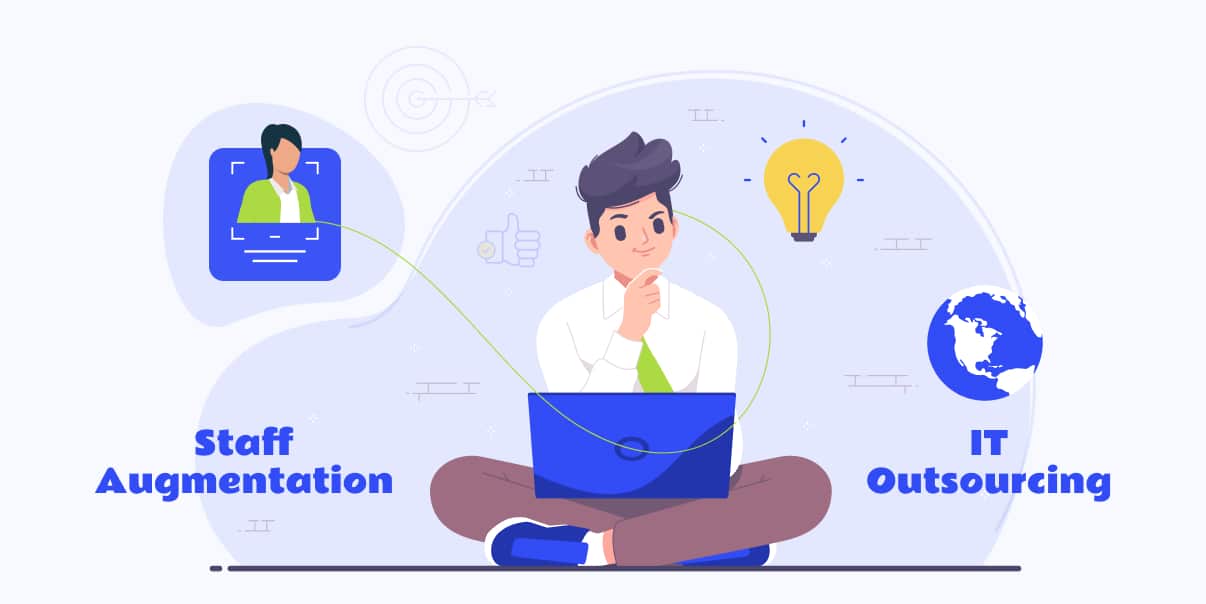Software Development Outsourcing Models
Harnessing Success through 3 Effective

Navigating the complex landscape of software development outsourcing can seem daunting for businesses. The challenges lie in understanding the various models’ pros and cons and determining which best fits a company’s needs.
This article demystifies this topic by examining three types of software development outsourcing models classified by location, relationship, and contract. It also presents each model’s unique features, benefits, and downsides. As we delve into the subject, we will highlight how selecting the proper model could directly impact project outcomes and your organization’s overall success.
Understanding the Need for Outsourcing Software Development
Outsourcing software development has become an attractive option for many businesses. The most prominent driving forces include cost efficiency, focusing on core competencies, and tapping into global talent pools. Let’s unpack these motivations further.
A significant number of companies outsource to reduce operational costs. However, the 2022 Deloitte Global Outsourcing Survey shows that cost efficiency has dropped to the fourth rank. In contrast, access to new capabilities, adjusting to business and operating model shifts, and keeping up with technology and regulations have become the top three reasons for outsourcing. This shift demonstrates businesses’ growing value on technical expertise and adaptability. It also emphasizes the evolution of outsourcing’s role from being a cost-saving strategy to a tool for acquiring new capabilities.
Another considerable advantage of outsourcing is the ability to focus on core competencies. For example, a retail company might choose to outsource its e-commerce platform’s development, allowing it to concentrate on its primary business operations — managing its supply chain and improving customer service.
Moreover, outsourcing opens the doors to a global talent pool, particularly relevant to industries facing skill shortages. According to the same Deloitte survey, talent acquisition, retention, and inadequate employee skills are among businesses’ most pressing internal challenges. Outsourcing can be a powerful solution, enabling companies to tap into expertise that may be scarce or unavailable locally.
Finally, it’s worth noting that the trend of outsourcing has had positive financial implications. Remarkably, 75% of executives reported revenue growth due to outsourcing, with one out of four indicating that the increase was over 10%.
In this article, we will discuss different software outsourcing models to understand how you can use them to overcome the mentioned challenges and drive success.
Model Classification 1: Location-Based Outsourcing Models
Location-based outsourcing models categorize service providers based on their location relative to the client. The choice of location can significantly influence aspects like communication, cost, and cultural compatibility.
Onshore Outsourcing
Onshore outsourcing refers to delegating tasks to a third-party company or freelancers in the same country as the client. This model allows for smoother communication and better alignment of work schedules due to the shared time zone.
However, onshore outsourcing can be expensive compared to other options due to the higher cost of living and labor rates in many developed countries. An example could be a U.S. tech startup outsourcing its software development to another company based in Silicon Valley.
Despite the cost, this model is often chosen when businesses require close collaboration, want to minimize potential communication barriers, or must comply with regulations mandating data handling within national borders.
Nearshore Outsourcing
Nearshore outsourcing involves partnering with a service provider in a neighboring country or the same geographical region. This model often brings a balance between cost-effectiveness and ease of communication.
For instance, a U.S. company outsourcing to a software development firm in Mexico can benefit from reduced labor costs compared to onshore outsourcing while maintaining relatively similar work schedules and more accessible travel arrangements for face-to-face meetings.
Nearshore outsourcing is particularly advantageous when a business has tasks that require frequent interaction and real-time communication but needs more money for onshore outsourcing.
Offshore Outsourcing
Offshore outsourcing refers to delegating tasks to a service provider in a distant country, often on a different continent. This model can offer significant cost savings due to lower labor costs in countries like India, the Philippines, or Ukraine.
For example, a European firm outsourcing software development to India can benefit from the vast pool of technical talent available at a fraction of European labor costs. However, this model may present challenges due to the significant time zone differences, potential language barriers, and cultural differences that could impact the collaboration process.
Despite these challenges, offshore outsourcing is a fitting choice when cost savings are a priority, the project has clear and defined guidelines, and the work can be done independently with little need for real-time interaction.
In each case, the relationship with the outsourcing team may involve different factors from various models in the following classifications. It’s important to remember that companies can use different outsourcing models for other vendors or partners in their outsourcing strategy. Thus, understanding these models is crucial in forming an effective outsourcing plan.
Model Classification 2: Relationship-Based Outsourcing Models
In relationship-based models, the focus is on the client’s relationship with the IT outsourcing provider. This relationship often dictates how much control the client has and affects the client’s and provider’s flexibility over outsourced tasks.
Staff Augmentation
Staff augmentation involves integrating outsourced professionals into your existing team to supplement your in-house capabilities. Essentially, you’re borrowing the technical talent you need from a third-party provider for a specific period or project.
Staff augmentation presents the notable advantage of adaptability, offering the chance to expand or reduce your workforce as the situation demands while maintaining direct oversight of the incorporated staff. For instance, to navigate a complicated project, a startup might enhance its team by bringing in a senior software engineer who could provide valuable guidance to the less experienced internal staff.
However, staff augmentation also comes with challenges. Since the client manages the outsourced team directly, this model can strain your existing management resources. Moreover, staff augmentation requires you to have the expertise to manage the technical aspect of the project.
Staff augmentation is best for companies that need to temporarily expand their team for a specific project or fill a skills gap, and they have the managerial resources to oversee the added staff.
Dedicated Team
A dedicated team model is when an outsourcing provider forms a team of professionals who work exclusively on your project. The outsourced partner manages this team, handling recruitment, administrative support, and infrastructure.
The dedicated team model allows clients to have a high level of control and engagement without administrative hassle. For instance, a software development company might use a dedicated development team in a lower-cost country to work exclusively on developing a new product, thereby reducing software development costs and freeing up their in-house team for other tasks.
However, this model is less flexible than staff augmentation when scaling the team size quickly. Also, it requires a long-term commitment and might not be suitable for short, one-off projects.
The dedicated team model is the perfect outsourcing model for long-term projects where there is a need for deep knowledge of the client’s business and ongoing engagement is required.
Managed Services
Managed Services extend beyond software development, encompassing IT support, network solutions, cybersecurity management, data backup and recovery, cloud services, and IT consulting. In this model, the provider takes full responsibility for IT functions, becoming the client’s IT department.
Managed Services can provide continuous development, maintenance, and support within software development. A business might choose Managed Services for software development if they need more in-house IT expertise, letting the client focus on its core business operations.
The model can free the client from technical management and bring in high levels of expertise. However, it offers less direct control over the team than the other models. It also requires trust in the outsourcing partner’s management and technical abilities.
Managed Services are a suitable choice when a company wants to outsource an entire function, has limited technical or managerial resources, and prefers a hands-off approach to software development.
Model Classification 3: Contract-Based Outsourcing Models
Contract-based outsourcing models primarily revolve around the payment structure and terms between the client and the outsourcing vendor. This arrangement decides how financial risks are shared and how much control a client has over the project.
Time & Materials
The Time & Materials model means the client pays for the time and resources the service provider spends on the project. This model is more suitable for complex and evolving projects.
One of the crucial benefits of this model is its flexibility, which allows for adjustments in project requirements and scope. For instance, an SMB needs to develop a software solution, but it foresees that the requirements will likely change. This model is flexible enough to accommodate that. Also, collaboration and transparency in cost are a must in this model.
However, in this model, the project’s final cost can be uncertain and difficult to predict. Since the client pays for the time and resources, it may lead to budget overruns due to the undefined project timeline and costs. There is also no incentive for efficiency and speed.
The Time & Materials model is ideal for projects where the scope, requirements, and implementation plan are not entirely clear at the outset or expected to change over time.
Project-Based Model
In the project-based outsourcing model, the outsourcing partner delivers a complete project for a client. The client provides the project requirements, and the partner takes care of the execution, requiring little supervision from the client. Then, payments are made based on the milestones reached. The project-based model is suitable for well-defined projects with stable, predictable requirements.
One example of this model is if a tech startup hires a software development firm to create an entire mobile app. This model’s cost is predictable, as the price is set in advance. Also, there is a lower risk for the client regarding timeline management.
However, any changes to the project scope might incur extra costs and even require different milestones. As such, it lacks flexibility compared to the time & materials model, and it cannot adapt to evolving needs. The partner is also uninvolved in decision-making since they can only execute the plan and deliver what the client asks.
Project-based outsourcing works well when the project’s scope is clear and the client prefers a hands-off approach.
Fixed Price Model
Under the fixed price model (also known as fixed-rate pricing or flat fee model), the client pays a fixed price for a specific deliverable, regardless of the time and resources used by the outsourcing vendor.
Like the project-based model, the payment amount is agreed upon initially. As such, some people use the two terms interchangeably. Still, there are nuanced distinctions. For one, the fixed-rate pricing model shifts the risk of covering additional costs to the outsourcing provider. So this model provides the most budget certainty and is the easiest to plan a budget for.
Fixed-rate pricing also shifts the execution risk to the service provider. A company might choose a fixed-price contract if it has a well-defined project with clear deliverables and a set deadline. This model has the lowest financial risk.
However, the fixed price makes this model inflexible. Any changes to the scope can lead to renegotiations and potential conflicts. The client-partner relationship may also become strained if requirements are not met within budget.
Fixed-rate pricing is best for short-term projects with clearly defined requirements and deliverables. However, some companies interchange “fixed price” and “project-based,” so clarify your contract’s terms and conditions.
Choosing the Right Software Outsourcing Model: Factors to Consider
Aligning your software outsourcing model with your business needs and objectives is crucial for achieving your desired outcomes. Several factors can influence your choice. Let’s discuss each one:
Factor 1: The Nature of the Project
The complexity, size, duration, and required skills for a project are pivotal in determining the most suitable software outsourcing business model.
More complex and extensive projects might benefit from dedicated teams or managed services, allowing for deep understanding and control over the project’s intricacies. However, smaller projects or those requiring specific skills for a limited time could lean towards staff augmentation or project-based models.
Factor 2: The Budget
Outsourcing costs are not limited to the price paid to the outsourcing partner; it also includes communication, coordination, and quality assurance costs. The cost of each model varies, with onshore often being the most expensive and offshore being the most affordable in terms of labor cost. Still, other expenses can add up in offshore models due to potential communication and coordination challenges.
Therefore, your budget might dictate your choice between onshore, nearshore, or offshore models and influence whether you opt for staff augmentation, a dedicated team, or managed services.
Factor 3: The Timeline
Outsourcing can accelerate project completion, but it’s essential to consider how different models might impact the timeline. Models offering direct control, like staff augmentation, facilitate faster decision-making.
In contrast, models like managed services take longer to set up. Still, they can provide continuous development, maintenance, and support. Fast-paced projects benefit more from time & materials or project-based contracts, allowing quick adjustments and flexibility.
Factor 4: The Level of Control
One deciding factor in choosing a software development outsourcing model is the level of control the client wants to maintain over the project and the outsourced staff.
If retaining control is paramount, models like staff augmentation or dedicated teams where you’re heavily involved in the day-to-day work might suit you. In contrast, getting managed services might be better if you prefer a hands-off approach since it gives the outsourcing partner full responsibility for the outsourced functions.
Factor 5: The Level of Risk
Risk tolerance plays a vital role in choosing between software development outsourcing models. Risks in outsourcing can include operational risks, such as delays or quality issues, and financial risks, like unexpected costs. A fixed-rate pricing model could minimize financial risk if your business has low-risk tolerance. Conversely, if you can accommodate higher risk for potentially more significant returns or flexibility, time & materials or project-based models might be appropriate. We will discuss ways to mitigate outsourcing risk in the next section.
Remember, the ideal outsourcing model depends on your project and your business’s unique characteristics. It’s not uncommon for companies to utilize different models for outsourcing various tasks or projects, taking advantage of the strengths of each model while mitigating their weaknesses.
Combined Software Outsourcing Models: Exploring Different Combinations
Now that you know the factors involved in the decision, you can make an informed choice. However, you can combine multiple models out of all the discussed models. The three classifications are not mutually exclusive, and outsourcing relationships in the real world often combine models from the three classifications.
Here are all possible combinations of the various software development outsourcing models mentioned earlier, as well as an example for each one:
- Offshore, Staff Augmentation, Time & Materials: A U.S. tech firm hires a software developer from an Indian company for a long-term software development project, with payment based on the hours worked.
- Offshore, Staff Augmentation, Project-Based: A UK business contracts an offshore company in the Philippines to augment its team for the duration of a specific project.
- Offshore, Staff Augmentation, Fixed Price Model: A French company hires a database administrator from a South African firm for a database migration project, paying a fixed price for the entire project.
- Offshore, Dedicated Team, Time & Materials: An Australian e-commerce company sets up a dedicated software development team with a Ukrainian IT firm, with payment based on the hours worked.
- Offshore, Dedicated Team, Project-Based: A German automaker sets up a dedicated team with a Chinese IT services provider to develop a new in-car entertainment system, with payment tied to project milestones.
- Offshore, Dedicated Team, Fixed Price Model: A Canadian company sets up a dedicated customer service team with a firm in the Philippines, paying a fixed monthly fee for the service.
- Offshore, Managed Services, Time & Materials: A U.S. company outsources its entire IT operations to an Indian managed services provider, with costs based on the actual hours of service provided.
- Offshore, Managed Services, Project-Based: A UK retailer outsources its e-commerce platform development to a managed services provider in India on a project basis.
- Offshore, Managed Services, Fixed Price Model: A Spanish firm outsources its IT operations to a Brazilian managed services provider for a fixed monthly fee.
Remember, each combination has its strengths and weakness. Choose an outsourcing model based on your business’s needs and context.
Common Challenges and Solutions in Software Development Outsourcing
Software development outsourcing presents various challenges that can affect project success. This section discusses these challenges and offers solutions to overcome them.
Overcoming Time Zone Differences
One outsourcing challenge, particularly in offshore models, is managing time zone differences. Time zone differences can lead to delays in communication and response times.
To overcome time zone differences, ensure a few hours of overlap in working hours for real-time interaction. Utilize project management tools and establish clear communication protocols to ensure timely progress updates.
Ensuring Cultural and Communication Compatibility
Differences in language, business practices, and social norms can lead to misunderstandings and delays. To overcome these differences, you must establish clear communication channels and protocols.
There are many strategies for bridging cultural gaps. Have regular video meetings to foster better understanding and relationships. You can also offer cultural sensitivity training, as well as inform your in-house teams about what things your outsourcing partner may be sensitive about. Also, choosing a nearshore outsourcing vendor can minimize cultural differences due to geographical proximity and similarities.
Managing Budget Constraints and ROI Expectations
Budget overruns and unmet return on investment (ROI) expectations are common concerns in outsourcing. A clear contract defining the scope, deliverables, and payment terms helps manage budget-related issues. Regularly tracking progress against milestones can help identify potential problems early.
Ensuring Quality and Adherence to Standards
Outsourcing can risk the quality of work and adherence to industry standards if not managed correctly. To ensure quality, define quality standards and benchmarks at the outset. Regularly review the job done, and include clauses in the contract about penalties for not meeting quality standards. Choosing an outsourcing company with proven expertise in your industry can also ensure adherence to industry standards.
Reducing Outsourcing Risk
As discussed earlier, outsourcing risks can be operational, financial, or quality-related. To
reduce these risks, perform due diligence before selecting an outsourcing company. Verify their track record, client testimonials, and industry reputation. Create a detailed contract outlining responsibilities, deliverables, quality standards, intellectual property protection, and conflict resolution procedures. Regular monitoring and communication can help detect issues early and facilitate their resolution.
Conclusion
In this guide, we’ve dissected various software development outsourcing models and how choosing the suitable model aligns with multiple factors. Dedicated teams and managed services often best serve complex projects. On the other hand, staff augmentation or project-based models excel for more minor, specific tasks. While onshore outsourcing can offer quality and ease of communication, offshoring, and nearshoring provide cost benefits. Direct-control models speed up decision-making, while others, like managed services, provide ongoing support. Risk tolerance, too, plays a crucial role, with fixed price models providing certainty and time & materials offering greater flexibility.
All in all, knowing how to navigate common outsourcing challenges is crucial in making outsourcing a successful business strategy. However, finding the right partner is as important as choosing the correct model. Here is where BIT Studios can help you.
BIT Studios offers comprehensive outsourcing solutions tailored to your needs. Whether you require staff augmentation, a dedicated team, or managed services, we have the skills, experience, and compliance track record to deliver quality software solutions. Contact BIT Studios today for a personalized consultation to discuss your software development outsourcing needs. Let’s drive your business forward together.
We’re BIT Studios!
At BIT Studios we specialize in designing, building, shipping, and scaling beautiful, usable products with blazing-fast efficiency



